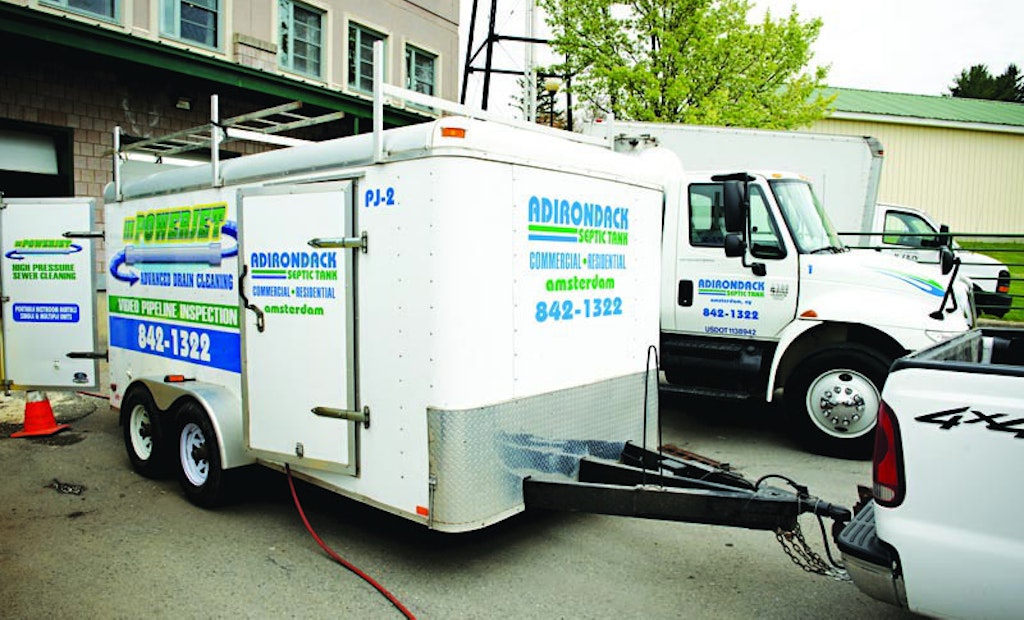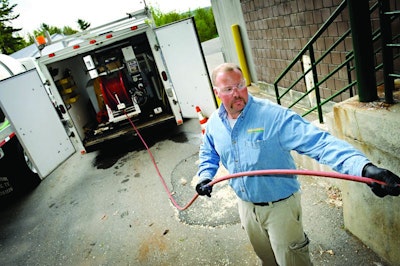
Interested in Trucks?
Get Trucks articles, news and videos right in your inbox! Sign up now.
Trucks + Get AlertsSometimes an equipment purchase leads contractors to unexpected jobs they never initially envisioned. That’s the case with Rick Zielinski, the owner of Adirondack Septic Tank, an Amsterdam, N.Y.-based company that primarily cleans and inspects drainlines and septic tanks.
In 2005, Zielinski bought a 4018 water jetter made by US Jetting Inc. His main objective: increased pressure to muscle through tough clogs. Pleased with the results, he bought another 4018 jetter in 2008. Both units are mounted in enclosed trailers and feature 300-gallon water tanks, 500-foot-capacity hose reels and pumps that generate pressure and flow of 4,000 psi at 18 gpm.
“We’ve had jetters since the mid-1980s, but they were lower psi/higher gpm units,” Zielinski says. “We wanted to go to higher-pressure units to be more productive with difficult drains … deal more effectively with tree roots and grease clogs.”
In that respect, the 4018s provided exactly what Zielinski sought. Talk about power: On one particular job, where a sewer-installation crew inadvertently flushed excess concrete and mortar into a new line while washing off tools and equipment, one of the 4018s actually removed the dried concrete and mortar.
“It was one of the tougher jobs we’ve encountered because all the new sewer lines ran under a manufacturing facility’s production floor, so it was virtually impossible to dig up the line and replace it,” Zielinski explains. “We saved that company a lot of money and effort. The jetter saved the day in that case. We got some ‘attaboys’ on that one.”
But the jetters also come up big in other creative applications. For example, at both a local college and a minimum-security prison, Adirondack crews used the jetter to clean out old, never-used conduit pipes, then inspected them to make sure they were ready for fiber-optic cable installations.
“In both cases, we had to confirm that the 3-inch-diameter conduit was still viable,” he explains. “But after that, we used the jetter to pull a small cable through the conduit so the fiber-optic installers had something to use to pull the fiber-optic cable through. We ran the jet to the far side of the line, then hooked up the smaller pulling cable and reeled the jet hose back in.
“Both machines have definitely opened up new markets for us,” he adds. “There are many jobs over the years that we wouldn’t have attempted without these jetters. We feel very confident about what they can do.”
Among others, the company also uses the jetters for jobs such as cleaning grease trap lines and breaking up greasy sludge inside grease traps, and cleaning leachate collection lines under landfills – some of them up to 1,000 feet long, which required adding an additional 500-foot-long hose. And during the past winter, which was unusually harsh, Zielinski says he used the 4018s to unclog frozen lines in everything from septic systems to force mains.
Zielinski prefers the enclosed trailers for two reasons: They allow the jetters to function during below-freezing temperatures and allow crews to carry as much equipment as possible. That averts time-consuming and profit-killing trips between job sites and the company’s shop.
The 14-foot, tandem-axle trailers are made by Wells Cargo and United Trailers Inc. The company also owns four pipeline-inspection cameras, three QuickView models made by Vivax-Metrotech Corp. and one unit made by Ratech Electronics. Each trailer carries two cameras. “It’s like wearing a belt and suspenders – if one breaks, you’ve got to have a backup plan,” Zielinski quips.
The newer of the two 4018s features a remote control, which Zielinski says is a very handy feature, especially in terms of employee safety.
“The remote doesn’t always eliminate the need for a second man,” he points out. “We still send out two guys on a job because safety first is a better way to do business. But the remote is very useful. If both guys on a crew are inside a building, they don’t have to run outside to turn it off.
“That’s not only convenient, it’s also safer,” he adds. “If both guys are in a building and water suddenly starts coming up another floor drain or out of some fixture, like a toilet or a sink, and there are electrical panels nearby, they can shut the jetter down quickly and assess the situation.”
Overall, Zielinski says the units – which cost about $38,000 and $42,000, respectively – have been a great investment. So good, in fact, that he’s strongly considering buying another unit.
“They’re one of the more profitable tools we have because there are no disposal costs involved with the work they do and they don’t require other materials in order to use them,” Zielinski says. “So there’s a better profit margin on the type of work they do.
“They generate a large percentage of our overall gross revenue,” he continues. “And they can provide stand-alone service or work in conjunction with our other equipment, like our vacuum trucks. I don’t know what we’d do without them.”






